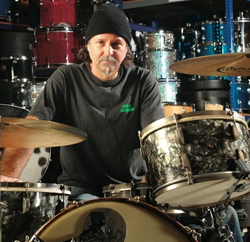
How about the kick drum? It’s the drum that engineers spend the most time on.
It’s weird for me because I always find them to be pretty easy because you muffle the kick drum on almost every session and when you do, it makes tuning easier. On the other hand, a tom has as much life as possible with no muffling.
What I would recommend is to take a down pillow and set it up so that it’s sitting inside the drum touching both heads. From there you can experiment, so if you want a deader, drier sound then you push more pillow against the batter head, and if you want it livelier, then you push it against the front head. That’s one way to go.
Another way to go is to take 3 or 4 bath towels and fold one of them so it’s touching both heads. If that’s not enough then put another one in against both heads on top of the first one. If that’s not enough then put another one in. Just fold it neatly so that they’re touching both heads. That’s a good place to start, then experiment from there.
Do you prefer a hole in the front head?
It makes it easier. I do some things without holes in the front head, but having it really makes it easy to adjust anything on the inside. No front head is good too. It’s usually a drier sound and you’re usually just packing the towels against the batter head. Just put a sandbag in front to hold the towels against the head.
How about cymbals?
One thing for recording is that you probably want a heavier ride but you don’t want that heavy of a cymbal for the crashes. You also have to be careful when you mix weights. For example, if you’re using Zildjian A Custom crashes you don’t want to use a medium. You want to stay with the thins rather than try to mix in a Rock Crash with that because the thicker cymbals are made for more of a live situation. They’re made to be loud and made to cut and sometimes they can sound a little gong-like to the mics. On the other side of the coin, if you playing all Rock Crashes and the engineer can deal with the level, that’s not so bad either because the volume is even, but a thinner cymbal mixed in with those would probably disappear.
What records better; big drums or smaller ones?
I depends what you want your track to sound like. When I started my company, people would always say to me “Why would someone want to rent your drums when they have their own set?” For one simple reason; most drummers have a single set of drums. If they’re going for a John Bonham drum sound, they’re not going to get it with say a “Ringo” set.
A lot of times when they go into the studio, the producer says, “You know, I really heard a 24” kick drum for this song. I hear that extra low end,” but the drummer’s playing a 22, so it’s important to have the right size drums for the song. If you’re going for that big double headed Bonham sound, you really should have a 26. If you’re going for a Jeff Porcaro punchy track like “Rosanna,” then you should probably have a 22. That’s my whole approach; you bring in the right instrument for the sound you’re going for. You don’t try to push a square peg into a round hole.
How much does the type of music determine your approach?
The drums that I bring for a hip-hop session are actually very close to what I bring for a jazz session. Usually the hip-hop guys want a little bass drum like an 18 and that’s what’s common for a jazz session, to have an 18 or a 20. Then maybe a 12 or a 14 inch rack tom, which is also similar to the jazz setup. The big difference is in the snare and hi-hats and the tuning of the kick drum and the snare.
On a jazz session I would keep the kick drum tuned high and probably not muffled. On a hip-hop record I would tune the kick probably as low as it would go and definitely not have any muffling so it has that big “boom” as much as possible. I would also have a selection of snares from like a 4 by 12 inch snare, 3 by 13 and maybe a 3 by 14. On a jazz record, I’d probably send them a 5 by 14 and a 6 1/2 by 14. The hi-hats on a jazz record would almost definitely be 14’s where a hip-hop record you’d want a pair of 10’s or 12’s, or maybe 13’s.
Obviously it’s open to interpretation because I’m sure a lot of hip-hop records have been made with bigger sets, but when I’ve delivered what I just said, it usually rocks their boat.
Go here for more on The Drum Doctors.
Bobby Owsinski is an author, producer, music industry veteran and technical consultant who has written numerous books covering all aspects of audio recording. Get the The Recording Engineer’s Handbook, Third Edition here.
